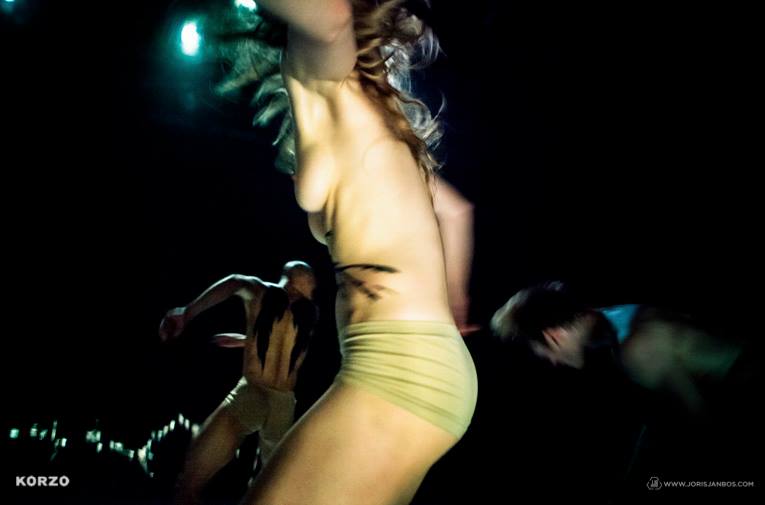Meer dan 10.000 versregels telt het gedicht Paradise Lost (1667) van Engelsman John Milton. Het kan niet eenvoudig zijn dat in een dansvoorstelling van een uur te vangen en toch is dat wat choreograaf Samir Calixto heeft willen doen. Eerder zette de jonge Braziliaan zijn tanden in Schuberts Winterreise en Vivaldi’s Vier Jaargetijden. Vrijdag opende hij met Paradise Lost het festival CaDance in Den Haag.
Het is donker op het podium, heel donker. In langzaam aanzwellende klanken zien we het silhouet van een gebogen rug met vleugels in een spotlight. Die spotlight komt steeds hoger te staan, of de gevleugelde persoon valt steeds dieper. Dan wordt de schim Samir Calixto zelf, die met twee zwarte vleugels op zijn rug getatoeëerd danst, soms strijdbaar, soms verscheurd door sterkere krachten. Hij representeert de gevallen engel Lucifer – alleen noemt hij die liever zelf niet zo en daar rijst een probleem.
Miltons epos beschrijft de val van de opstandige engel uit de hemel, en hoe die zich vervolgens als slang manifesteert in het paradijs. In die gedaante verleidt hij Eva tot het eten van de boom van de kennis van goed en kwaad – en de zondeval en verbanning uit het paradijs zijn onvermijdelijk geworden.
De transformatie van Lucifer in de slang is niet een doorsnee gegeven in het christendom en behoeft dus enige toelichting. Maar in plaats daarvan heeft Calixto besloten het juist ingewikkelder te maken. Zijn drie personages mogen geen Adam, Eva en Lucifer heten, maar ‘hij’, ‘zij’ en ‘het’. In die drieëenheid staan ‘hij’ en ‘zij’ voor harmonie, ‘het’ voor ontwrichting en rebellie –niet perse het kwaad. De rol van ‘het’ bij Calixto doet denken aan Herman Hesses Demian, waarin de hoofdpersonen zich spiegelen aan de Bijbelse Kaïn. Kaïn, broedermoordenaar, maar ook degene die actief de loop der dingen verandert.
De keuze om de personages vrij te laten zijn van naam én van morele waarde (goed of kwaad) maakt de voorstelling moeilijk te begrijpen zonder kennis van het werk van Milton. Het stuk wil vragen oproepen: is er wel een goed en kwaad? Is rebelleren tegen harmonie slecht? Hoe zou de rol van religie eigenlijk moeten zijn? Maar om die extra laag te duiden moet de toeschouwer eerst de essentie van Miltons epos weten en daarvan kun je niet zomaar uitgaan. Al is er met enig gissen een hoop te interpreteren. Zo vinden de getatoeëerde vleugels bij ‘het’ hun equivalent in de boom (van kennis?) op de buik en rug van ‘hem’ (Quentin Roger) en ‘haar’ (Ewa Sikorska).
Blijft over een prachtig gedanst, soms beklemmend en soms ontroerend stuk. Roger en Sikorska bewegen in golvend unisono, terwijl Calixto met heftige impulsbewegingen en verbeten “Ts!”-geluiden het evenwicht uitdaagt. Aanvankelijk doet hij dat vanachter het spiegelende, halfdoorzichtige achterdoek, later staat hij op de vloer om een of beide partners mee te voeren in zijn rebellie.
Als ‘hij’ en ‘zij’ uiteindelijk vallen, is ‘het’ al niet meer op het podium aanwezig. Getweeën vechten zij vergeefs tegen het licht van een sterke spot. Wellicht de engel met het vlammend zwaard, die onder zwaar gedreun de gevallenen uit het paradijs verjaagt. Vanuit die gebroken toestand gaan zij op zoek naar een nieuw begin.
Samir Calixto experimenteert de laatste tijd veel met beweging vanuit adem en klankuitstoting. Ook speelt hij graag met lichtbronnen, die in Paradise Lost soms bijna het karakter van een personage aannemen. Helaas is het toneel vaker dan nodig in schemerduister gehuld en dat werkt na verloop van tijd vermoeiend.
Ook het geluidsontwerp is aan de zware kant. De Brits-Haagse Kate Moore componeerde voor Paradise Lost ‘No Man’s Land’, uitgevoerd door vier leden van het Amsterdam Cello Octet. Indringende, subtiele muziek, die schuurt en dreigt. Harmen Straatman combineerde het met een bestaand fragment van Knaifel en veel sfeergeluiden. Calixto overwoog oorspronkelijk om naast Moore’s stuk een nummer van Led Zeppelin in te zetten; ik ben nieuwsgierig hoe dat zou hebben uitgepakt.
Maar het meest te winnen heeft Paradise Lost toch bij meer duidelijkheid. Wat is er mis met een samenvatting van Miltons epos in één alinea op het programmablad? Dan heeft de toeschouwer een aanknopingspunt en blijft er van daaruit nog genoeg te filosoferen.
Gezien: Theater aan het Spui, Den Haag, 30 januari 2015. Nederlandse tournee 26 februari tot en met 28 april. Bekijk de trailer op YouTube
Ook gezien op CaDance: Strike Root van Nederlands Dans Theater en My Private Odyssey van Club Guy and Roni.

